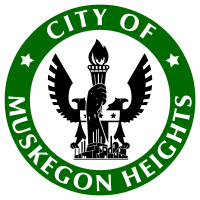Attention
**Boil Water Advisory for Muskegon Heights**
4/25/2024 12:48pm: Update on Boil Water Advisory The City of Muskegon Heights Department of Public Works continues to address the recent system pressure drop, which remains a concern for our community. As we work diligently to resolve this matter, we are providing important updates on our ongoing response efforts and safety precautions for our residents.…
Read MoreUpdated Zoom Link for City Council Meetings as of 06/27/2022
Updated Zoom Link for City Council Meetings as of 06/27/2022 https://us02web.zoom.us/j/81115643157?pwd=UCZCVMWhf_IPCGepQLIX1TyrvgzYlU.1
Read MoreHeights City Market 2022
Market Season 2022, Fridays May thru October
Read MoreFull Time Fire Fighter Job available
2022 Parks & Recreation Master Plan
Full Plan
Read MoreNew program meets growing demand for public works employees in West Michigan communities
Full story
Read MoreDelano Restoration Project
East Delano Avenue Reconstruction, Muskegon County Phase One Start: November 2021 Phase One End: November 2021Phase Two Start: Spring 2022 Phase Two End: Spring 2022Investment: $650,000 What Is Being Done? The project involves full depth reconstruction of two lanes of undivided roadway in two phases: Phase One: Asphalt Removal Sidewalk and curb removals Storm sewer…
Read MoreRecreational Fire Information
… Recreational Fire Information … A recreational fire permit is required to have a recreational wood burning fire in the City of Muskegon Heights. Self-contained gas or propane fire containers are allowed within the City and do not require a permit – but please follow the manufacturer’s instructions and, if applicable, check with your landlord…
Read MoreRestaurant Revitalization Fund applications and guidelines
Information from The U.S. Small Business Administration (SBA) regarding Restaurant Revitalization Fund applications and guidelines. To learn more about the application process, please visit www.sba.gov/restaurants. Restaurant Revitalization FundThis program provides emergency assistance for eligible restaurants, bars, and other qualifying businesses impacted by COVID-19. Program detailsThe American Rescue Plan Act established the Restaurant Revitalization Fund (RRF) to provide…
Read More